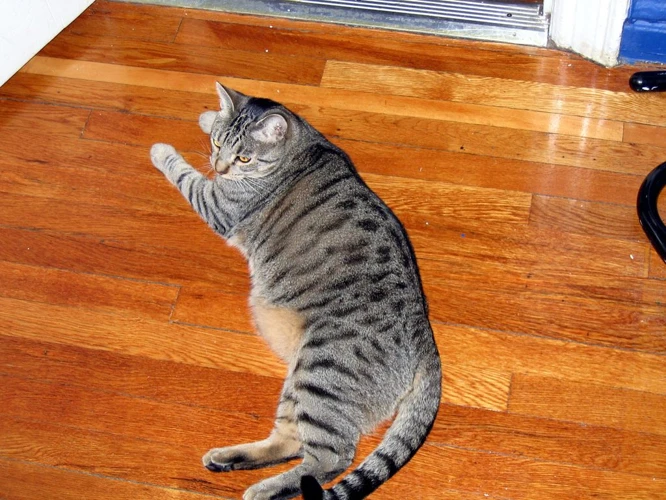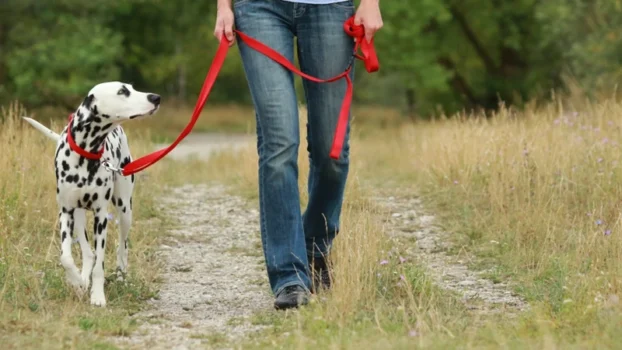We all know how much cats love their independence and how they can be incredibly picky about what they do and do not like. However, did you know that it’s possible to train your California Spangled to walk on a leash? Yes, you read that right! Walking your cat on a leash can be a fun and exciting experience for both you and your furry friend. But, where do you begin? In this comprehensive guide, we’ll break down the steps you need to take to train your California Spangled to walk on a leash, address common problems, and even make it a rewarding experience. So, let’s get started!
Understand Your Cat

Understanding your California Spangled cat is the first and most important step in training them to walk on a leash. Cats have their own personalities and comfort levels, and it’s essential to respect them during the training process. While some cats may take to walking on a leash immediately, others may need more time and patience. By understanding your cat’s personality and behavior, you can tailor your training approach to best suit their needs and ensure a successful training outcome. Once you have a good understanding of your cat, you can proceed to the next step and start training them using positive reinforcement.
Get to Know Your Cat’s Personality
Understanding your California Spangled’s personality is crucial before beginning leash training, as every cat is unique and will have its own strengths and weaknesses. Some cats are more outgoing and adaptive, while others may be more timid and hesitant. Observe your cat in different situations and try to understand its likes and dislikes. This will help you create a training plan that is tailored to your cat’s temperament.
Here are some personality traits you should consider when getting to know your cat:
- Sociability: Is your California Spangled social and enjoys being around people or other pets, or is it more independent and solitary?
- Courage: Does your cat seem fearless and curious, or easily frightened by new stimuli?
- Activity Level: Is your cat high-energy and playful, or more laid-back and relaxed?
- Intelligence: Is your cat quick to learn new things or slower to catch on?
- Training Eagerness: Is your California Spangled interested in training and learning new things?
By understanding these personality traits in your cat, you can create a training plan that takes into consideration your cat’s individual needs. For example, if your cat is easily frightened, you may need to start training at a slower pace and in a more controlled indoor environment. On the other hand, if your cat is high-energy, you may need to provide extra physical and mental stimulation to keep it engaged in the training process.
Remember that training your California Spangled to walk on a leash requires patience and consistency, and understanding your cat’s personality is just one piece of the puzzle. Consider positive reinforcement training techniques, such as clicker training or using treats, to make the training experience enjoyable for your cat. With time, effort, and a good understanding of your cat’s personality, you can successfully train your California Spangled to walk on a leash. If you need additional information, check out our article on training California Spangled cats with positive reinforcement or clicker training techniques.
Practice Handling Your Cat’s Paws
When training your California Spangled cat to walk on a leash, it is vital to have patience and ensure that your cat is comfortable. One necessary step in this preparation is to practice handling your cat’s paws. As cats are not customary to have their paws handled like dogs, they may get nervous or uncomfortable when their back feet leave the ground. Here are some simple steps to help you practice handling your cat’s paws:
- Hold your cat securely in your lap. Be sure to communicate calmly and gently to ensure that your cat is calm.
- Start by softly touching your cat’s paws and nails, extending the paws, and rubbing the top of the paws. This technique will help your cat get acquainted with the touch on its delicate paws.
- Practice massaging your cat’s paws and toes. Gently stroke to help ease any tension or uncomfortableness. You can use treats to keep your cat interested and content during this process.
- Increase the time interval between rubbing the paws, in between the toes, and pressing down the nails. You must be patient and continue this training until your cat is comfortable handling his paws.
By regularly practicing handling your cat’s paws and keeping it comfortable with touch, you will eventually be able to put on the leash and harness and start training your California Spangled to walk. If you need additional tips for training and handling your cat, you can check out our article on teaching tricks to your California Spangled cat, litter training your California Spangled kitten, or how to deal with unwanted behaviors.
Prepare for Training

Before you start training your California Spangled to walk on a leash, it’s important to prepare for the process. This involves getting the right equipment and setting up an appropriate indoor training area. By taking these steps, you can help ensure that your cat is comfortable and safe throughout the training process. In this section, we will discuss the necessary preparation steps in detail. Let’s get started!
Get a Proper Leash and Harness
When preparing to train your California Spangled to walk on a leash, it’s important to invest in a proper leash and harness. Choosing the right equipment will make the training process smoother and more comfortable for your feline friend.
Leashes: When it comes to leashes, there are several options to choose from. A standard leash can be used, but retractable or bungee leashes are also good choices for cats. It’s important to make sure the leash is light and flexible, so your cat doesn’t feel weighed down or uncomfortable.
Harnesses: Harnesses are recommended over collars, as they distribute pressure more evenly across your cat’s body. When choosing a harness, look for one that fits snugly but is still comfortable for your cat to move around in. A poorly fitting harness can cause discomfort and even breathing difficulties for your cat.
To help you make the right decision, here is a table comparing different types of leashes and harnesses:
| Leashes | Pros | Cons |
|---|---|---|
| Standard Leash | Simple and affordable. | May not be long enough for outdoor walks. |
| Retractable Leash | Gives cats more freedom to explore. | Can be heavier and less flexible. |
| Bungee Leash | Reduces tension on the leash and provides more comfort for your cat. | May not be suitable for cats who pull on the leash. |
| Harnesses | Pros | Cons |
| Step-In Harness | Easy to put on and adjust. | May not be as secure as other harnesses. |
| H-Style Harness | Offers more support and control. | May be more difficult to put on. |
| Vest Harness | Provides the most support and control. | May be less breathable and warmer for your cat. |
Remember that every cat is different, so it’s important to choose equipment that suits your California Spangled’s size, temperament, and training goals. A combination of different leashes and harnesses may also be useful, depending on the situation. Ultimately, the key is to find equipment that your cat feels comfortable and safe wearing.
Indoor Training Area
It’s important to have a designated indoor training area where you can teach your California Spangled to walk on a leash. Here are some things you can do to set up the perfect space for training:
- Clean and declutter: Choose a room that is free from any potential hazards or distractions. Remove any fragile objects or furniture that your cat could accidentally knock over or damage. Make sure the room is clean and free of any sharp objects that could harm your cat.
- Provide scratching posts: Your cat will want to scratch and stretch, so make sure you have plenty of scratching posts or pads available. This will help prevent your cat from damaging your furniture or carpets.
- Set up a litter box: Make sure your cat has access to a clean litter box in the training area. This will prevent accidents from happening and ensure your cat is comfortable and relaxed.
- Make it cozy: Add some comfortable bedding, blankets, or pillows for your cat to relax on. This will make the training area feel safe and comfortable.
- Minimize noise and distractions: Turn off any loud music or TV and close the windows to minimize outside noise. You want your cat to be able to focus on the training without any distractions.
By creating the perfect indoor training area, you are setting your California Spangled up for success in learning to walk on a leash. Remember to always supervise your cat during training sessions and make sure they are comfortable and happy throughout the process.
Start Training

Now that you have a good understanding of your California Spangled’s personality and have prepared for training, it’s time to begin the process of teaching your furry friend to walk on a leash. Starting the training process can be both exciting and daunting, but with patience and persistence, you’ll soon have a happy cat who enjoys going for walks with you. In this section, we’ll discuss the key steps to start your training journey, from introducing the harness to taking those first steps outdoors. So, let’s get started!
Introduce the Harness
When introducing your California Spangled to a harness, it’s important to make the experience as comfortable and positive as possible. Follow these steps to introduce the harness successfully:
- Start Slowly: The first step is to let your cat sniff and explore the harness on their own. Place the harness near their food dish or bed so they can get used to its presence without feeling threatened.
- Pair the Harness with Rewards: Once your cat is comfortable with the presence of the harness, it’s time to start pairing it with rewards. Offer your cat treats or positive reinforcement every time they approach or inspect the harness. This will help them associate the harness with positive experiences.
- Let Your Cat Wear the Harness: Once your cat is used to the presence of the harness and associates it with positive experiences, it’s time to let them wear it. Start by putting the harness on your cat for short periods, such as during meal times or while playing. This will help them get used to the feeling of wearing a harness.
- Adjust for Comfort: It’s essential to make sure the harness fits your cat snugly but comfortably. Adjust the straps accordingly, so the harness doesn’t rub or cause your cat any discomfort.
By following these steps, you will be able to introduce the harness to your California Spangled with minimal stress and discomfort. Remember, a comfortable and well-fitting harness is crucial for your cat’s safety and enjoyment when walking on a leash.
Let Your Cat Explore the Harness and Leash
Before you can get your California Spangled cat walking on a leash, they need to be comfortable wearing a harness and leash. This step is crucial, as some cats may feel restricted or confined by the harness and leash, making it difficult to train them to walk on a leash.
To help your cat get familiar with the harness and leash, allow them to explore it on their own terms. This can be done by following these steps:
- Introduce the Harness: Show the harness to your cat. Let them sniff it and investigate it. This helps them associate the harness with something familiar and safe.
- Put the Harness on Your Cat: Once your cat is comfortable with the harness, try putting it on. Start by placing the harness on their back for a few seconds and then take it off. Repeat this process several times, gradually increasing the amount of time the harness is worn.
- Attach the Leash: Once they’re comfortable with wearing the harness, attach the leash and allow them to roam around indoors. Supervise your cat at all times to ensure their safety.
- Practice, Practice, Practice: Make sure your cat wears the harness for short periods of time each day. The more they wear it, the more comfortable they’ll become with the sensation of wearing it.
It’s essential to be patient and allow your cat time to adjust to the harness and leash. Never force your cat into a harness as this can cause fear and frustration. By patiently introducing the harness and allowing your cat to explore it on their own terms, you’ll be one step closer to successful leash training.
First Walks Indoors
Indoor training is the first step in teaching your California Spangled to walk on a leash. Before taking your cat outdoors, it’s important to ensure that they’ve mastered a relaxed and comfortable walk indoors. Start by picking a quiet room in your house, free of distractions and other pets. Here’s what you need to know before embarking on the first walks indoors:
| Step | Description |
|---|---|
| Step 1 | Put the harness and leash on your cat, but don’t pull on the leash. Allow your cat to relax and become accustomed to the feeling of wearing the harness. |
| Step 2 | Start walking your cat around the room on the leash. Keep the leash slack and follow your cat’s lead. If your cat becomes overwhelmed or seems hesitant, stop and let them relax. |
| Step 3 | Encourage your cat with positive reinforcement, like treats or toys. Use a cheerful voice to praise your cat for walking calmly on the leash. |
| Step 4 | Gradually increase the distance of your indoor walks. Once your cat seems comfortable with walking on the leash indoors, move to a larger room or space with more distractions to further challenge them. |
Remember that every cat is different, so it’s important to work at a pace that’s comfortable for your cat. Don’t rush the training process, as it can be overwhelming for your cat and may hinder their progress. With patience and consistency, your California Spangled will soon be walking confidently on a leash both indoors and outdoors.
Outdoor Walks
Taking your California Spangled for an outdoor walk requires extra caution and preparation. Before taking your cat outside, ensure that it has fully adjusted to wearing the leash and harness. Make sure you choose a calm and quiet location for your first outdoor walks. Here are some additional tips to help make your cat’s outdoor walks a success:
| Pick the Right Time | Choose a time of day when there aren’t many distractions or loud noises. Early morning or late evening can be ideal. |
| Keep Your Distance | As your cat is exploring the outside world, make sure you keep a safe distance from other animals and pedestrians to avoid any incidents. |
| Use Positive Reinforcement | Encourage your cat and offer treats throughout the walk to reinforce the positive behavior of walking on a leash. |
| Be Prepared for Emergencies | Always have a plan for emergencies, such as a dog running up to your cat. Carry a small can of compressed air or a whistle to startle any potential attackers and help keep your cat safe. |
| Watch for Signs of Overstimulation | Just like humans, cats can become overstimulated or overwhelmed. Keep a watchful eye on your cat for signs of distress, such as excessive vocalization or panting. |
Taking your California Spangled for a walk on the leash can be a great bonding experience while providing them with some exercise and fresh air. By following these tips, you can help ensure a safe and enjoyable outdoor walk for both you and your furry friend.
Teach Basic Commands

A well-behaved and obedient California Spangled is a joy to have as a companion. Teaching your cat basic commands is not only practical, but it also strengthens the bond between you and your feline friend. By using a patient and positive approach, you can easily train your cat to follow simple commands like “sit,” “stay,” “come,” and “stop.” These basic commands will make your walks together more enjoyable and safer for both of you. Let’s dive into the step-by-step guide to train your California Spangled with basic commands.
Sit
One of the basic commands that you can teach your California Spangled to become a well-behaved walking partner is the “Sit” command. This will come in handy when you need your cat to pause and wait for instructions. Here are the steps to follow:
- Start with your cat standing in front of you.
- Hold a treat in front of your cat’s nose and slowly move it upwards.
- This will cause your cat to look up, which will naturally lower its hindquarters to a sitting position.
- As soon as your cat sits, praise it enthusiastically and reward it with the treat, saying “Good sit!“
- Repeat this process several times, gradually phasing out the use of the treat and reinforcing the command with verbal praise alone.
- Once your cat responds reliably to the “Sit” command indoors, you can start practicing outdoors during your walks.
It’s important to keep in mind that every cat learns at its own pace, so don’t get frustrated if your California Spangled takes a while to get the hang of it. Consistency is key to success, so practice regularly and make sure to always reward your cat for good behavior. With patience and persistence, your cat will be sitting on command in no time, making your walks together much more enjoyable.
Stay
Teaching your California Spangled cat to “Stay” is an essential command for leash walking. It is best to start teaching this command indoors and only move outside once your cat has mastered it. The following table illustrates the step-by-step guide on how to teach “Stay” command to your feline friend:
| Step | Action |
|---|---|
| 1 | With your cat sitting calmly, say “Stay” in a firm but calm voice while holding out your hand in front of them. |
| 2 | Wait for a few seconds, and if your cat remains seated, reward them with a treat or a toy and lots of praise. |
| 3 | If your cat moves or becomes distracted, gently guide them back into position and repeat the command. |
| 4 | Slowly increase the length of time that your cat stays in place before giving the reward, but don’t make it too long initially. |
| 5 | Once your cat has mastered staying in place for several seconds, you can try moving away a few steps and repeating the command from a distance. Gradually increase the distance until you can walk across the room and your cat stays in place until you return. |
| 6 | Practice frequently, but keep the training sessions short and fun to avoid overstimulation. |
By patiently following these steps, your California Spangled should learn to stay in place on command, which will make leash walking more manageable and enjoyable for both of you. Remember to use positive reinforcement, like treats and praise, rather than punishment for the best results.
Come
Teaching your California Spangled to come when called is an essential command that can keep your pet safe in a variety of situations. Here’s how to train your cat to come on command using positive reinforcement techniques:
| Step | Action |
|---|---|
| Step 1: | Choose a word or phrase that will be your cat’s recall command, such as “come,” “here,” or “now”. Use this command consistently throughout training and as your cat’s recall word in the future. |
| Step 2: | Start indoors in a quiet room with no distractions. Call your cat’s name and give the recall command. When your cat comes to you, reward her with a treat and lots of praise. Repeat this step several times a day until your cat consistently comes to the recall command indoors. |
| Step 3: | Add distance by calling your cat from another room or a short distance away. Continue to reward her with treats and praise when she comes to you. |
| Step 4: | Practice outdoors in a secure, fenced area with no distractions. Call your cat’s name and the recall command from a short distance and reward her when she comes to you. Gradually increase the distance and practice with distractions. |
| Step 5: | Consistently use the recall command to call your cat to you in a variety of situations, such as mealtime, playtime, or when it’s time to come inside. Reward her every time she comes to you, even if you didn’t call her. |
Remember, training your California Spangled to come on command may take some time, patience, and practice. Always use positive reinforcement techniques and reward your cat for coming to you. Never punish or scold your cat for not coming, as this can damage the bond of trust between you and your pet. With patience and consistency, you can teach your cat this essential command and keep her safe in a variety of situations.
Stop
Training your California Spangled to stop on command is an important skill that ensures your cat’s safety and control during walks. Here are some steps to teach your cat to stop:
- Choose a Safe Location: Find a safe and quiet area in your training zone to teach this command. Stand a few feet from your cat holding the leash and your cat’s favorite treat.
- Use a Command: Choose a simple but clear command like “stop” or “halt”. Once your cat is in front of you, say the command firmly but calmly.
- Stop Walking: Stop walking when you say the command and gently pull the leash straight up to your waist to make your cat stop too.
- Reward: As soon as your cat stops, praise and reward them with a treat to reinforce the behavior.
- Repeat and Increase Distance: Repeat the command and reward process while gradually increasing the distance between you and your cat. This helps your cat learn the command and obey it even when they are farther away.
- Use Leash Corrections: If your cat doesn’t stop, stop moving and give a gentle tug on the leash. This will let your cat know that you are serious and that they need to obey the command.
Remember that it may take time and patience for your California Spangled to learn this command properly. Be consistent with your training and rewards, and practice regularly. Once your cat has mastered this command, you will have a stronger bond and a happier and safer walking experience together.
Address Common Problems

While training your California Spangled to walk on a leash can be a fun and rewarding experience, it is not always smooth sailing. It’s not uncommon for cat owners to face some challenges and obstacles along the way. In this section, we will discuss some of the common problems that cat owners may encounter and provide some solutions and tips to overcome them. So don’t worry if you’re facing some issues in training your feline friend – we’ve got you covered! Let’s dive in and find solutions to these problems together.
Pulling on the Leash
One common problem when training your California Spangled to walk on a leash is pulling on the leash. This can be frustrating and potentially dangerous if your cat runs away and gets loose. Here are some steps you can take to address this issue:
1. Use a training collar or harness: A training collar or harness can help discourage your cat from pulling on the leash. Make sure it is properly fitted and not too tight or too loose.
2. Use positive reinforcement: When your cat walks without pulling, reward them with treats or praise. Reinforce good behavior rather than punishing bad behavior.
3. Use short leashes: A shorter leash gives you more control and can prevent your cat from getting too far ahead and pulling on the leash.
4. Stop the walk: If your cat pulls on the leash, stop walking and wait for them to calm down before continuing. This reinforces that pulling on the leash doesn’t lead to continued walking.
5. Use a consistent routine: Consistency is key when training any pet. Stick to the same routine and commands each time you walk your cat on a leash to reinforce good behavior.
Here is a table summarizing the steps to address pulling on the leash:
| Step | Description |
|---|---|
| 1 | Use a training collar or harness |
| 2 | Use positive reinforcement |
| 3 | Use short leashes |
| 4 | Stop the walk |
| 5 | Use a consistent routine |
Remember, each cat is unique and may require different techniques and levels of training. Patience and consistency are key when training your California Spangled to walk on a leash.
Refusing to Walk or Move
Your California Spangled may refuse to walk or move during training, which can be frustrating. However, it’s important to understand that this behavior is completely normal, especially for a first-time walker. Here are some reasons why your cat may refuse to move, and what you can do to encourage them:
1. Fear or Anxiety: Your cat may be scared or anxious about going outside, especially if they’ve never been outdoors before. To combat this, try taking your cat to a quiet, secluded area for their first walks. Use positive reinforcement, like treats or praise, to help ease their anxiety and associate the outdoors with positive experiences.
2. Overstimulation: Walking on a leash can be overwhelming for a cat, especially if there are a lot of new sights, sounds, and smells. If your cat becomes overstimulated, they may freeze or try to run away. To avoid this, start with short, slow walks and gradually increase the length and complexity of your walks as your cat becomes more comfortable.
3. Fatigue: Walking on a leash is a physical activity, and your cat may tire more quickly than you expect. Be mindful of your cat’s energy level and stop if they become too exhausted. Start with short walks and gradually increase the duration and intensity of your walks as your cat builds up their stamina.
4. Discomfort: Your cat may be uncomfortable with the harness or leash, which can cause them to refuse to move. Make sure the harness fits properly and is comfortable for your cat. Rubbing a bit of catnip on the harness may also help encourage your cat to wear it.
By understanding the reasons behind your cat’s reluctance to walk, you can tailor your approach and make training more effective. Remember to be patient and encouraging, and always use positive reinforcement to reward good behavior. With persistence and dedication, your California Spangled will eventually become a confident and happy leash walker.
Overstimulation
Overstimulation is a common problem that California Spangled cats can experience during training. Overstimulation occurs when the cat becomes overwhelmed or overexcited by the training process. Some signs of overstimulation include hyperactivity, excessive biting or scratching, and restlessness. It is important to be able to recognize and address overstimulation in your cat to prevent any harm or injury.
Tips for addressing overstimulation:
- Start with shorter training sessions and gradually increase the duration as your cat becomes more comfortable.
- Avoid training during times when your cat is likely to be overstimulated, such as after meals or play sessions.
- Take breaks during training sessions to allow your cat to rest and recharge.
- Provide a calm and quiet training environment to reduce sensory overload.
- Use calming aids such as pheromone sprays or diffusers to promote relaxation.
- Adjust the training routine or techniques to better suit your cat’s personality and needs.
- Consult with a veterinarian or professional cat trainer for additional guidance and support.
Remember to always be patient and understanding when training your California Spangled cat. Overstimulation is a normal part of the learning process, and with time and practice, your cat will become more comfortable and less prone to overstimulation. By following these tips and approaches, you can help ensure a safe and positive training experience for both you and your cat.
Fear or Aggression
Dealing with fear or aggression during walks with your California Spangled can be a challenging and potentially dangerous situation. It is essential to understand the underlying cause of your cat’s behavior and address it accordingly. Here are some tips to help you manage fear or aggression during walks:
- Assess the situation: If your cat is displaying aggressive behavior, try to identify the trigger. Is it a certain sound or sight? Are they uncomfortable with other animals or people? Understanding what causes the aggression can help you avoid those triggers in the future.
- Stay calm: If your cat becomes fearful or aggressive during a walk, do not panic. Calmly and gently remove them from the situation and give them space to calm down. Getting worked up and angry will only escalate the situation.
- Use positive reinforcement: Encourage good behavior with positive reinforcement. Offer treats and praise when your cat displays desired behavior, such as walking calmly on the leash or socializing with other animals.
- Consider seeking professional help: If your cat’s fear or aggression is persistent or severe, consider consulting with a professional animal behaviorist. They can help you develop a customized behavior modification plan to address your cat’s specific needs.
Remember, each cat is unique and may require different strategies to overcome fear or aggression during walks. Patience, consistency, and positive reinforcement are key to success.
Make Walking Fun and Rewarding
Walking your California Spangled on a leash can be a fun and rewarding activity for both you and your feline friend. However, it’s important to make sure that your cat enjoys these walks just as much as you do. This requires more than simply getting them to walk on a leash – it requires creating an enjoyable experience that keeps your cat engaged and stimulated. In this section of the article, we will explore some ways to make walking fun and rewarding for your California Spangled. From bringing treats and toys to changing up the walking route, these tips will help make your cat’s leash training a truly delightful experience.
Bring Treats and Toys
Cats are curious creatures, and they are often motivated by food and play. That’s why bringing treats and toys along during a walk with your California Spangled can be an effective way to make it a fun and rewarding experience for your feline friend.
Treats: Fill a small bag with your cat’s favorite treats before heading out for a walk. Use them to reward good behavior during the walk, such as walking calmly on the leash, sitting, or staying on command. Always offer the treats immediately after the desired behavior, so your cat will associate the positive experience with the activity you want to encourage.
Toys: Playing with your cat during the walk can also be an effective way to keep them interested and engaged. Bring along a favorite toy, such as a feather wand or a laser pointer, and use it to play with your cat during breaks. This can help to relax your cat if they become restless or overstimulated during the walk.
Make it Interactive: Bringing treats and toys along for a walk with your California Spangled can be a great way to bond with your cat and make the experience more interactive. You can also try hiding treats along the route, so your cat can use their hunting instincts to find them. This can make the walk more exciting for your cat and add an extra level of stimulation to their outdoor experience.
However, it’s important to be cautious about your cat’s food intake and to avoid overfeeding, so be sure to adjust your cat’s daily meal intake accordingly if you’re supplementing with treats on walks. Bringing treats and toys along can greatly enhance the walking experience and help to build a positive association with the activity for your California Spangled.
Change Up the Walking Route
One way to make walking more enjoyable for your California Spangled is to switch up the route. Walking the same route day after day can become mundane and boring for both you and your feline companion. To keep things interesting, try taking different paths or exploring new areas in your neighborhood.
1. Choose a Different Path: Instead of taking the same route every time you walk your cat, try going in a different direction or exploring a new side street. This can help keep your cat engaged and interested in their surroundings.
2. Head to New Locations: Consider taking your cat to nearby parks, walking trails, or even a pet-friendly beach. This can expose them to new sights and smells, and provide a change of scenery.
3. Mix Up the Terrain: Changing the type of terrain you walk on can also provide new stimulation for your cat. Try walking on dirt, grass, sand, or even up a hill to provide a different challenge for them.
4. Take a Break: If you have been walking for a while and your cat seems to be losing interest, take a break and let them relax for a bit. You can also use this time to play with them or give them treats to keep them engaged.
By changing up the walking route, you can help keep your California Spangled engaged and interested in the walk. This can also help them burn off excess energy and prevent boredom. Remember to always stay alert and aware of your surroundings, and be prepared for any unexpected obstacles or hazards on your walk.
Stay Positive and Encouraging
When training your California Spangled to walk on a leash, it’s important to stay positive and encouraging. Cats respond well to positive reinforcement and rewards, so be sure to praise and treat them when they follow your commands or walk calmly on the leash.
One way to reward your cat during leash training is to use a clicker. This is a small device that makes a clicking sound when pressed and is commonly used in training animals. Click the device when your cat does something correctly, and then immediately give them a treat. This will help your cat associate the clicking sound with a positive experience and encourage them to repeat the behavior.
Another way to stay positive during leash training is to avoid punishment or scolding. This can be counterproductive and cause your cat to become afraid or disobedient. Instead, use positive reinforcement to encourage good behavior.
Lastly, remember to be patient and reassuring with your California Spangled during leash training. This is a new experience for them and it may take time for them to adjust. Use a soothing tone of voice and give them plenty of praise and rewards for their efforts. With time and practice, your cat will be happily walking on a leash with you in no time!
| Ways to Stay Positive | Why it’s Important |
|---|---|
| Use a clicker and treats | Encourages positive behavior and creates a positive association with leash training |
| Avoid punishment or scolding | Prevents fear and disobedience in your cat during training |
| Be patient and reassuring | Helps your cat feel calm and comfortable during leash training |
Conclusion
In conclusion, training your California Spangled cat to walk on a leash takes patience, practice, and understanding of your cat’s personality and behavior. It is important to start with indoor training and gradually move to outdoor walks while teaching basic commands such as sit, stay, come, and stop. Addressing common problems like pulling on the leash or fear and aggression requires understanding and positive reinforcement.
Making the training fun and rewarding is essential to keeping your cat engaged and willing to learn. Bringing treats and toys and changing up the walking route can keep your cat interested and motivated. Remember to stay positive and encouraging throughout the training process.
By following the step-by-step guide outlined in this article and being attentive to your cat’s individual needs, you can successfully train your California Spangled cat to walk on a leash. With time and practice, you and your furry friend can enjoy the benefits of exploring the outdoors together.
Frequently Asked Questions
Can all cats be trained to walk on a leash?
Most cats can be trained to walk on a leash. However, some may not enjoy it as much as others.
What type of leash and harness should I use?
A harness that fits your cat snugly and a leash that is lightweight are the best options. Avoid retractable leashes as they can be dangerous for cats.
How long should training sessions be?
Training sessions should be short, around 10-15 minutes each. It is better to have multiple shorter sessions instead of one long session.
What if my cat refuses to wear a harness?
Introduce the harness slowly and gradually. Leave it near your cat’s usual spot and let them get used to it. Reward them for sniffing and investigating the harness, then move onto putting it on for short periods of time.
What do I do if my cat pulls on the leash?
Stop walking and wait for your cat to walk back to you. Give them a treat or verbal praise when they return. Repeat this process if they continue to pull.
Should I punish my cat if they misbehave during training?
No, punishing your cat can create a negative association with training and make them less likely to cooperate in the future. Instead, use positive reinforcement and rewards for good behavior.
Can I take my cat for walks in crowded areas?
It’s best to avoid crowded areas as your cat may become overstimulated or stressed. Stick to quieter areas where your cat can explore with less distractions.
What if my cat becomes afraid or aggressive during training?
Always prioritize your cat’s safety. If they become afraid or aggressive, stop training and try again later. Slowly introduce the harness and leash and never force your cat to do something they don’t want to do.
What if my cat still refuses to walk on a leash after training?
Not all cats will enjoy walking on a leash. If your cat refuses to walk on a leash, it’s perfectly okay to let them explore and play indoors or in a secure outdoor space.
How often should I take my cat for walks?
It depends on your cat’s personality and preferences. Some cats may enjoy daily walks, while others may prefer weekly or occasional walks. It’s important to pay attention to your cat’s body language and adjust accordingly.







